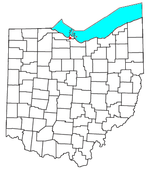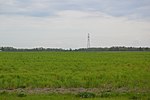Port Clinton Light
1833 establishments in OhioLighthouses completed in 1833Lighthouses completed in 1896Lighthouses in Ohio

Port Clinton Light is a lighthouse in Port Clinton, Ohio, United States at the northern end of Water Works Park. It was previously located on the outer end of the west pier which is located at the city's harbor entrance. This lighthouse has two incarnations that were built with different materials. Only the present structure survives as it was moved to a marina and replaced by a skeleton tower in 1952. The marina then sold the lighthouse back to the city, and it was placed in the park fully restored. At just 20 ft (6.1 m), Port Clinton Light is recorded as the shortest lighthouse in the state.
Excerpt from the Wikipedia article Port Clinton Light (License: CC BY-SA 3.0, Authors, Images).Port Clinton Light
Washington Street,
Geographical coordinates (GPS) Address Nearby Places Show on map
Geographical coordinates (GPS)
| Latitude | Longitude |
|---|---|
| N 41.515 ° | E -82.9344 ° |
Address
Port Clinton Lighthouse
Washington Street
43452
Ohio, United States
Open on Google Maps








